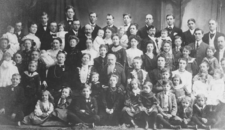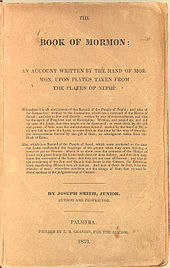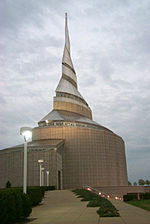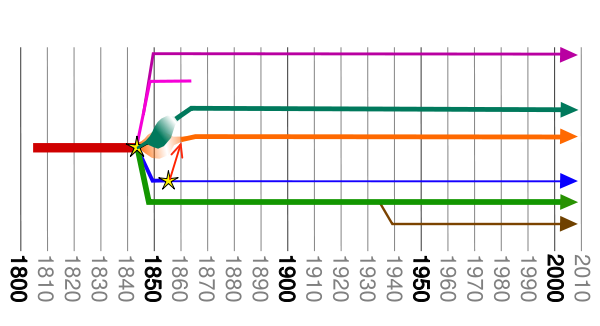- Community of Christ (differentiation from LDS Church)
-
Community of Christ 
Classification Restorationist Orientation Latter Day Saint movement Theology Trinitarian,
MormonismPolity Hierarchical Leader Stephen M. Veazey Headquarters Independence, Missouri Origin April 1830[1]
Reorganized: April 6, 1860
Fayette, New York
Reorganized: Amboy, IllinoisSeparations Community of Christ sects Members 250,000[2] Temples 2 Official website www.CofChrist.org The Church of Jesus Christ of Latter-day Saints 
Classification Restorationist Orientation Latter Day Saint movement Polity Hierarchical Leader Thomas S. Monson Separations LDS denominations Congregations 28,109 Members 13,508,509[3] Missionaries 52,494[3] Temples 129[4] Official website www.lds.org The Community of Christ, formerly the Reorganized Church of Jesus Christ of Latter Day Saints (RLDS), and The Church of Jesus Christ of Latter-day Saints (abbreviated as the LDS Church) are two separate denominations that share a common heritage in the Church of Christ founded by Joseph Smith, Jr. on April 6, 1830 in western New York, through its first 14 years until 1844. They have evolved separately in belief and practices ever since. While the LDS Church claims more than thirteen million members worldwide,[3] the Community of Christ claims approximately 250,000 members worldwide.[2]
Contents
Recent transformation in Community of Christ
Significant doctrinal, organizational, and attitudinal changes in the Community of Christ since 1960 have further reduced similarities that remained with the LDS Church. While the doctrine and belief system of the LDS church is highly centralized and systematic, the Community of Christ has demonstrated an adaptive and decentralized approach to doctrine. In 1997, the Community of Christ initiated a three-year formal period of transformation entitled “Transformation 2000,” that was seen by then President of the Community of Christ, W. Grant McMurray as the culmination of a series of changes dating back to 1960.[5] McMurray identified these changes as a movement away from a belief that the denomination was “the restored church” and towards a position within mainstream Christianity. By a vote of 1,979 to 561, at the Community of Christ World Conference of 2000, the name of the church was changed from the “Reorganized Church of Jesus Christ of Latter Day Saints” to Community of Christ. The church was attempting to distance itself from comparisons with Mormonism and in the process transform itself into a unique position among mainstream Christian denominations.
As the first president of the Community of Christ since 1830 that was not a direct descendant of Joseph Smith, Jr., McMurray sought to formalize changes in thinking about prophetic leadership, the historical basis of the Book of Mormon, and the concept that priesthood authority had been restored in the 1830s after centuries of apostasy.[6] During his presidency, the church moved from close communion to open communion and McMurray even began to open the door to priesthood ordination for practicing homosexuals, something which he acknowledged was already occurring. Negative response to this issue forced McMurray to reaffirm the official policy prohibiting ordination of sexually active gays and lesbians. However, the church allows those who were ordained against policy, to continue in priesthood office.
Prior to 1960 the church’s identity was often tied to its differences with the much larger LDS church. McMurray cited a 1960 world tour by former president W. Wallace Smith as a pivotal event impacting the evolution of church beliefs. Leaders such as Roy Cheville had already been teaching a new generation of church members a more ecumenical and open-minded system of beliefs. But it was the church’s proselytizing of cultures in countries outside North America that knew little about Christianity, much less Mormonism, that forced reassessment of denominational practices and beliefs. Apostle Charles Neff, a leading church missionary, pushed fellow leaders and field ministers towards a relativistic doctrinal viewpoint motivated by a combination of practical missionary concerns and an attitude of theological openness. These significant moves of the Community of Christ towards alignment with liberal Protestant doctrine were influenced in part by many in church leadership who pursued theological studies at St. Paul School of Theology in Kansas City, Missouri, and elsewhere. While the Community of Christ had long been known for its anti-polygamy doctrine, its outreach efforts amongst the Sora people in India brought a re-examination even on this issue.
Former church president Wallace B. Smith’s call for the ordination of women to the priesthood in 1984 was a milestone in the doctrinal evolution of the church away from traditional doctrines and towards progressive Christianity. During his term in office, greater attention was brought to peace and justice issues. The call to dedicate the Independence Temple to “the pursuit of peace” is regarded as both a symbolic and practical evidence of the differences between the two denominations. While the Latter-day Saint church has a set of highly developed temple rituals and sees temples as sacred space for the sealing of covenants related to its celestial doctrine, the Community of Christ understanding of Temple is reflective of the understanding of Temple in the 1830s, that is a center for spirituality, ministerial education, and church administration.
These and other changes comprised a fundamental shift in thinking from restorationism to mainline Protestant liberalism. They have been identified as a deconstructionist trend in the theology of the Community of Christ as well as an obvious set of differences with the LDS Church. These recent differences only added to the list of long-standing doctrinal differences between the two groups. Nearly all of the traditional differences between the two groups also can be seen as aligning the Community of Christ more closely with traditional Christian teaching and neo-orthodoxy.
Historical differences between the churches
Main article: Community of Christ historyThe Community of Christ was founded by the confederation of a number of smaller groups that declined to migrate with Brigham Young to Utah or follow any of the others vying to become the successor to Joseph Smith, Jr. Prior to the reorganization conference of 1860, numerous doctrinal differences were espoused by the leaders of the various splinter groups. Following the reorganization, these differences were formalized into a litany of what might now be called wedge issues.[7]
The differences enumerated below characterize the major differences between The Church of Jesus Christ of Latter-day Saints and the Community of Christ.[8]
Scriptures
Bible
The Inspired Version of the Bible is part of the Community of Christ canon of scripture,[9] although it does not prescribe a single translation of the Bible.[10]
The LDS Church generally uses the Authorized King James Version in English (although Brigham Young University professors in FARMS publications and elsewhere at times use other translations in citations), especially their own edition which is extensively footnoted with corrections from the Inspired Version.[11] The LDS Church refers to the Inspired Version as the "Joseph Smith Translation."[12] The version of the Bible that the LDS Church gave away as a free Bible in the 1990s and into the 21st century as a way to create a contact for more people with missionaries was a King James Version with few if any footnotes and no references to the Joseph Smith Translation. Since nearly half of Mormons speak a language other than English the King James Version has never been seen by many of them.
Book of Mormon
Community of Christ holds the Book of Mormon as a second canon of scripture,[13] and views the Book of Mormon as an additional witness of Jesus Christ. It publishes two versions of the book through its official publishing arm, Herald House. The Authorized Edition is based on the original printer's manuscript and the 1837 Second Edition (or Kirtland Edition) of the Book of Mormon. Its content is similar to the Book of Mormon published by the LDS church, but the versification is different[14] Community of Christ also publishes a 1966 "Revised Authorized Edition" which attempts to modernize some of the language.[14]
In 2007 President Stephen M. Veazey ordered a resolution to "reaffirm the Book of Mormon as a divinely inspired record."[13] He stated that "while the Church affirms the Book of Mormon as scripture, and makes it available for study and use in various languages, we do not attempt to mandate the degree of belief or use. This position is in keeping with our longstanding tradition that belief in the Book of Mormon is not to be used as a test of fellowship or membership in the church."[13]
Doctrine and Covenants
Both churches publish a book called the Doctrine and Covenants.[15][16] The Community of Christ has removed several early sections[17] and adds new "inspired documents" to the book regularly.[18] The LDS church has made about seven additions since the 1844 edition.[16]
Pearl of Great Price
The Community of Christ has never published or considered the Pearl of Great Price to be scripture.[15] Unlike the Community of Christ, the LDS Church includes the Pearl of Great Price as part of its standard works.[19]
Leadership succession
The first five[20] of the seven presidents of the Community of Christ were direct descendants of Joseph Smith, Jr.[21] President McMurray was the first president of the church who was not a member of the family of the Smith family.[21] While never formally accepting a principle of lineal succession, the denomination originally taught that Joseph Smith, Jr. had designated his son, Joseph Smith III, as his successor.[22]
By contrast, the LDS church believes the right of determining a successor lies with the Quorum of the Twelve Apostles.[23] By tradition, the most senior member of the quorum becomes the president of the LDS church.[23]
While this is an area that marked a traditional difference between the two denominations. A recent succession crisis forced the Council of Twelve Apostles of the Community of Christ to utilize a procedure similar to that of the LDS Council of Twelve Apostles.[24] Current President Stephen M. Veazey (himself president of the Twelve, but not the senior member) was selected as successor by the Council of Twelve due to Grant McMurray’s decision to not name a successor.[24][25]
The calling a non-descendant of Joseph Smith to the presidency was the justification used to create a schism within the Community of Christ. This led to the creation of the Remnant Church of Jesus Christ of Latter Day Saints. The prophet of the Remnant Church, President Frederick Niels Larsen, is a direct descendant (maternal 2nd great-grandson) of Joseph Smith, Jr. The church has its headquarters near the Temple Lot, across from the headquarters of the Community of Christ.
Godhead
The Community of Christ teaches trinitarian principles.[26] The LDS church sees the Godhead as composed of three physically distinct personages.[27]
Exaltation
The LDS church does teach the principle of exaltation,[28] which has no counterpart in the Community of Christ.[7]
Adam-God doctrine
Main article: Adam-God doctrineAccording to Brigham Young, the Adam–God doctrine was first taught orally by Joseph Smith, Jr. before his death in 1844. However, the evidence that Smith originated the doctrine consists of Young's own assertions,[29] and a 1877 recollection of Anson Call,[30] and circumstantial evidence collected by Mormon fundamentalist writers.[31] Since The Community of Christ was founded by the confederation of a number of smaller groups that declined to migrate with Brigham Young to Utah, the Adam-God doctrine has never been a part of Community of Christ teachings.[7] While LDS leaders traditionally teach that God was once a man (fifth LDS President Lorenzo Snow),[32] the Latter-day Saint president Spencer W. Kimball officially denounced the Adam-God theory.[33][34]
Priesthood eligibility
Community of Christ priesthood has always been open to persons of all races,[35] and was opened to women in 1984.[36] The LDS priesthood is open to males only[37][38] and until 1978 was partially closed to people of African descent,[37] who are sometimes viewed as "descendants of Cain".[39][40]
Temple rites
The Community of Christ does not practice and has traditionally objected to temple ceremonies or rituals.[7] Unlike the LDS Church, the Community of Christ's temples are open to the public.[41] The LDS beliefs in and temple practice of celestial marriage and baptism for the dead have never been embraced by the Community of Christ.[7]
Historically, the Community of Christ did include revelations in its Doctrine and Covenants,[42] presented by Joseph Smith Jr., which sanctioned baptism for the dead and temple worship.[7] However, the Community of Christ considered baptism for the dead conditional on the completion of the Nauvoo Temple in a reasonable amount of time.[43] The membership of the Church failed to do so, and therefore the right to perform baptisms for the dead was withdrawn and should be instituted only very temporarily.[43]
Additionally, the 1970 World Conference concluded that sections 107, 109, 110, 113 and 123 (regarding baptism for the dead and temple worship) had been added between the 1835 and 1844 editions without proper approval of a church conference. The World Conference removed[17] those sections to a historical appendix (which also included documents that were never published as sections).[17] The World Conference of 1990 subsequently removed the entire appendix from the Doctrine and Covenants.[17]
Use of cross
The Community of Christ utilizes the symbol of the cross on its buildings and temples.[44] By contrast, the LDS Church does not use the cross, stating "because the Savior lives, we do not use the symbol of His death as the symbol of our faith".[45] However, nearly every LDS temple has a statue of the Angel Moroni.[46] Nonetheless, the LDS Church does not consider the angel Moroni to be an official symbol of that faith and "has no policy regarding the use of statues of the angel Moroni atop temples".[47]
Polygamy
 Family of Polygamist Joseph F. Smith, sixth president of The Church of Jesus Christ of Latter-day Saints (LDS Church) and nephew of Joseph Smith Jr.
Family of Polygamist Joseph F. Smith, sixth president of The Church of Jesus Christ of Latter-day Saints (LDS Church) and nephew of Joseph Smith Jr.
Polygamy has never been accepted or taught by the Community of Christ.[48] Smith's son Joseph Smith III and widow Emma Smith challenged the evidence presented and taught that Joseph Smith Jr. opposed the practice of polygamy and was not a polygamist.[49][50][51] Some members of the Community of Christ have accepted the viewpoint of historians that these were indeed taught and practiced by Joseph Smith Jr, but that like some of the prophets of ancient Israel, Joseph Smith Jr had a time when he followed a wrong path.[48] Therefore most members reject these doctrinal development.[7][48]
Tithing
Traditionally, the Community of Christ taught that tithing should be calculated as one-tenth of a member’s discretionary income[52] while the LDS tithe on total income.[53] Recently, however, the Community of Christ has adopted a program known as Disciples' Generous Response which encourages generosity as a response to God rather than as a calculated obligation.[52]
Apostasy and Restoration
 Stained glass depiction of the first vision of Joseph Smith, Jr., completed in 1913 by an unknown artist (LDS Museum of Church History and Art).
Stained glass depiction of the first vision of Joseph Smith, Jr., completed in 1913 by an unknown artist (LDS Museum of Church History and Art).
The LDS church teaches that Joseph Smith, Jr. restored the fullness of the gospel after a centuries long period known as the great apostasy.[54][55] The LDS church is seen as a restoration of fallen Christianity.[54] By contrast, the Community of Christ has abandoned its traditional tenet that it is the “one true church” and adopted a viewpoint that all faith traditions can offer a pathway to spiritual enlightenment.[56] In a recent article on the Faith and Beliefs of the Community of Christ, Barbara McFarlane Higdon called the Community of Christ a "unique member of the body of Christ, the universal community of believers."[57] Higdon's article also suggests that prior claims that the church had been "restored" were tantamount to idolatry. The Community of Christ has moved towards ecumenism and inter-faith dialogue. Nevertheless, the Community of Christ "steadfastly affirms the primacy of continuing revelation instead of creedal rigidity..." Also, it should be noted that Community of Christ's version of the Doctrine and Covenants contains revelations (such as Section 1) that indicate that the Church is the one true church.[58]
Other revelations make mention of the unique authority of the priesthood of the Church, and the Church of course still considers Joseph Smith Jr., to be its founder, with priesthood authority going back to him, and Smith himself received a vision in which he was expressly taught that no church (at that time) was valid.[59] It was for this reason that he was called by God to establish a new church, which would then, logically (being established by divine directive) be the one true church.[59] Joseph's account of this vision is still published by the Church.[60] Today, the Community of Christ generally refers to the First Vision as the "grove experience" and takes a flexible view about its historicity,[61] emphasizing the healing presence of God and the forgiving mercy of Jesus Christ felt by Joseph Smith.[62]
Notes
- ^ The Early Church (1830), Community of Christ website (accessed July 16, 2008)
- ^ a b "CofChrist General Denominational Information". Community of Christ. 2009. http://www.cofchrist.org/news/GeneralInfo.asp. Retrieved 2009-04-29.
- ^ a b c Statistical Report 2008
- ^ Chronological List of Temples
- ^ Transforming the Church, 1998 leadership address accessed July 28, 2006. (PDF file)
- ^ 1996 Salt Lake Tribune news article, website cache accessed July 29, 2006. McMurray is quoted as stating that the Book of Mormon: “falls outside the traditional standards of historical documentation and veracity.”
- ^ a b c d e f g Elbert A. Smith, Differences That Persist between the RLDS and LDS Churches, (1950), website accessed 2008-06-11.
- ^ LDS - RLDS: Differences & Similarities, website accessed July 28, 2006.
- ^ Brown, Rich, Web site of The Community of Christ - Sacrament - A Sacrament of Blessing and Promise, Herald, http://www.cofchrist.org/sacraments/blessing/blessing-brown.asp, retrieved 3 September 2009 Note: Paragraph 14 says “The unique teachings offered in the Inspired Version (Joseph Smith’s emendations of the King James translation of the Bible) add significantly to our theological understanding.”
- ^ Euritt, Mark, Official Web site of The Community of Christ - Sacrament - The Sacrament of Ordination, Herald, http://www.cofchrist.org/sacraments/blessing/blessing-brown.asp, retrieved 3 September 2009 Note: Paragraph 3 refers to the King James Version (referred to as the Authorized Version of the Bible), the New Revised Standard Version (NRSV), and the New International Version (NIV) Bibles.
- ^ Official Web site of the Church of Jesus Christ of Latter-day Saints: The Old Testament, see footnotes
- ^ Official Web site of the Church of Jesus Christ of Latter-day Saints: Joseph Smith Translation “Selections from the Joseph Smith Translation of the Bible
- ^ a b c Andrew M. Shields, "Official Minutes of Business Session, Wednesday March 28, 2007," in 2007 World Conference Thursday Bulletin, March 29, 2007. Community of Christ, 2007.
- ^ a b The Herald House (Press for the Community of Christ) 1966 "Revised Authorized Edition"
- ^ a b Basic Beliefs: Scripture, Official Web site of The Community of Christ, http://www.cofchrist.org/OurFaith/faith-beliefs.asp, retrieved 2 September 2009
- ^ a b Doctrine and Covenants of The Church of Jesus Christ of Latter-Day Saints, Official Web site of the Church of Jesus Christ of Latter-day Saints, http://scriptures.lds.org/en/dc/contents, retrieved 2 September 2009
- ^ a b c d Community of Christ, Doctrine and Covenants - Doctrine and Covenants 107 see header
- ^ Section 163, Official Web site of The Community of Christ, http://www.cofchrist.org/D&C163/, retrieved 2 September 2009 Added by the presidency of Stephen M. Veazey (2005)
- ^ The Pearl of Great Price, Official Web site of the Church of Jesus Christ of Latter-day Saints, http://scriptures.lds.org/en/pgp/contents, retrieved 2 September 2009
- ^ Under leadership of..., Official Web site of The Community of Christ, http://www.cofchrist.org/history/, retrieved 2 September 2009 Note List of Church Presidents in side frame
- ^ a b Niebuhr, Gustav (12 May 1996), New Leader For Church That Shares Mormon Roots, The New York Times, http://www.nytimes.com/1996/05/12/us/new-leader-for-church-that-shares-mormon-roots.html, retrieved 19 June 2009
- ^ Our Faith: Frequently Asked Questions: Frequently Asked Questions?, Official Web site of The Community of Christ, http://www.cofchrist.org/ourfaith/faq.asp, retrieved 3 September 2009
- ^ a b Brent L. Top and Lawrence R. Flake, “ ‘The Kingdom of God Will Roll On’: Succession in the Presidency”, Ensign, Aug. 1996, 22. See "The Principles of Succession in the Church Today: #1
- ^ a b Associated Press (7 March 2005), Community of Christ selects new president, INDEPENDENCE, Mo, http://www.deseretnews.com/article/1,5143,600117063,00.html, retrieved 19 June 2009
- ^ Stephen M. Veazey, cofchrist.org, accessed March 2, 2008.
- ^ Faith and Beliefs: Our Faith and Beliefs: God, Community of Christ, http://www.cofchrist.org/ourfaith/faith-beliefs.asp, retrieved 13 August 2009
- ^ lds.org entry on "Godhead"
- ^ "Topic Definition - Eternal Life", Official LDS Church Website 9 June 2008.
- ^ Collier (1999, p. 229 fn. 12) (citing minutes of meeting of the Quorum of Twelve, 4 April 1860, in which it was recorded: "It was Joseph's doctrine that Adam was God…God comes to earth and eats and partakes of fruit. Joseph could not reveal what was revealed to him, and if Joseph had it revealed, he was not told to reveal it."). Collier (1999, p. 360) (citing Wilford Woodruff Journal of 4 September 1860, in which George Q. Cannon said "that Adam is our Father [and] is a true doctrine revealed from God to Joseph & Brigham. For this same doctrine is taught in some of the old Jewish records which have never been in print...."). Collier (1999, p. 367) (citing Wilford Woodruff Journal of 16 December 1867, stating that "President Young said Adam was Michael the Archangel, & he was the Father of Jesus Christ & was our God & that Joseph taught this principle.")
- ^ Collier (1999, p. 233) (citing an 1877 reminiscence of Anson Call, who said he heard Joseph Smith say: "now regarding Adam: He came here from another planet [as] an immortalized being and brought his wife, Eve, with him, and by eating of the fruits of the earth became subject to death and decay and he became of the earth, earthly, was made mortal and subject to death.").
- ^ See, e.g., Collier (1999, pp. 228–42) (a fundamentalist author, arguing that Joseph Smith believed and taught the doctrine).
- ^ Newsroom, The official resource for news media, opinion leaders and public: The Godhead, The Church of Jesus Christ of Latter-day Saints, http://www.newsroom.lds.org/ldsnewsroom/eng/background-information/the-godhead, retrieved 13 August 2009
- ^ Conference Report, p. 115 (October 1–3, 1976)
- ^ Spencer W. Kimball, “Our Own Liahona,” Ensign, Nov. 1976, p. 77.
- ^ Faith and Beliefs, webpage, retrieved June 17, 2006
- ^ Community of Christ, Doctrine and Covenants Section 156:9C-D [1] see 9C and 9D
- ^ a b The Church of Jesus Christ of Latter-day Saints, Doctrine and Covenants: Official Declaration #2 [2]
- ^ Basic Beliefs: The Restoration of\Truth: The Restoration of the Priesthood, Official Web site of The Church of Jesus Christ of Latter-day Saints, http://www.mormon.org/mormonorg/eng/basic-beliefs/the-restoration-of-truth/the-restoration-of-the-priesthood, retrieved 2 September 2009 Paragraph 4
- ^ McConkie, Bruce (1966), Mormon Doctrine
- ^ Taylor, John (28 August 1881), Journal of Discourses, 22, Delivered At Sunday Afternoon General Conference, Provo, UT,: Albert Carringtonv 42, pp. 304, http://contentdm.lib.byu.edu/cdm4/document.php?CISOROOT=/JournalOfDiscourses3&CISOPTR=9616&REC=2, retrieved 2 September 2009
- ^ Our Faith: Frequently Asked Questions: Do you perform sacraments in your Temple in Independence?, Official Web site of The Community of Christ, http://www.cofchrist.org/ourfaith/faq.asp, retrieved 3 September 2009
- ^ Community of Christ, Doctrine and Covenants Sections 107, 109, 110, 113 and 123
- ^ a b Baptism for the Dead, by Apostles Charles R. Hield and Russell F. Ralston (RLDS Church)
- ^ Official Web site of Community of Christ: Virtual Tour: Exterior Cross
- ^ Gospel Library: Gospel Topics: Cross, Official Web site of The Church of Jesus Christ of Latter-day Saints, http://www.lds.org/ldsorg/v/index.jsp?vgnextoid=bbd508f54922d010VgnVCM1000004d82620aRCRD&locale=0&sourceId=ea7d0bbce1d98010VgnVCM1000004d82620a____, retrieved 8 September 2009
- ^ Eight LDS temples do not have an angel Moroni (either in original design or added later). For list see LDSChurchTemples.com: Interesting Facts: Angel Moroni Statues #1
- ^ Greenwood, Val D. (July), "“I Have a Question”", Ensign: 66–67, http://www.lds.org/ldsorg/v/index.jsp?hideNav=1&locale=0&sourceId=8e383ff73058b010VgnVCM1000004d82620a____&vgnextoid=2354fccf2b7db010VgnVCM1000004d82620aRCRD, retrieved 8 September 2009
- ^ a b c Our Faith: Frequently Asked Questions: What position does Community of Christ take on Joseph Smith Jr.’s alleged involvement in polygamy?, Official Web site of The Community of Christ, http://www.cofchrist.org/ourfaith/faq.asp, retrieved 3 September 2009
- ^ Whitmer 1887
- ^ Times and Seasons, Volume 5, page 423 and 474
- ^ The Latter-Day Saints' Millennial Star 4, January 1844, 144
- ^ a b Stewardship: An Old Path Made New, webpage, retrieved June 24, 2006
- ^ Gospel Library: Gospel Topics: Tithing, Official Web site of The Church of Jesus Christ of Latter-day Saints, http://www.lds.org/ldsorg/v/index.jsp?index=20&locale=0&sourceId=e141f73c28d98010VgnVCM1000004d82620a____&vgnextoid=bbd508f54922d010VgnVCM1000004d82620aRCRD, retrieved 8 September 2009
- ^ a b James E. Talmage, The Great Apostasy (1909, Salt Lake City: Deseret Book) [3]
- ^ Apostasy from The Divine Church by James L. Barker
- ^ Basic Beliefs: The Church, Official Web site of The Community of Christ, http://www.cofchrist.org/OurFaith/faith-beliefs.asp, retrieved 2 September 2009
- ^ Higdon, Barbara McFarlane, "Faith and Beliefs: The Church," HERALD, September 2006, p. 22-23.
- ^ Community of Christ, Doctrine and Covenants Section 1
- ^ a b Edwards, Paul M. (September 1991), Our Legacy of Faith: A Brief History of the Reorganized Church of Jesus Christ of Latter Day Saints, Independence, MO: Herald Pub House, pp. 335, ISBN 0830905944
- ^ The Saints Herald (RLDS Church publications) 31 (40): 643, 8 June
- ^ According to its website, the church "does not legislate or mandate positions on issues of history. We place confidence in sound historical methodology as it relates to our church story. We believe that historians and other researchers should be free to come to whatever conclusions they feel are appropriate after careful consideration of documents and artifacts to which they have access. We benefit greatly from the significant contributions of the historical discipline." Community of Christ website.
- ^ Our History - Introduction
External links
- Official Website of the Community of Christ
- Official Web site of The Church of Jesus Christ of Latter-day Saints
- Herald House, official publishing arm of the Community of Christ
- John Whitmer Historical Association, a scholarly society focused on Community of Christ history
- Restoration Bookstore Bookstore by restonationist fraction.
Denominational Tree
Main branches of the Latter Day Saint movementThe Community of Christ History Joseph Smith, Jr. • Joseph Smith III • First Vision • Amboy Conference • Sidney Rigdon • Emma Smith • Lyman Wight • Alpheus Cutler • William Smith • David Whitmer
Beliefs and Practices Sacred Texts Worship and Culture Organization Leadership Prophet-president • Stephen M. Veazey • First Presidency • Council of Twelve Apostles • Presiding Bishop • Presiding Evangelist • David R. BrockCriticism and Controversy Joseph Smith and polygamy • Joseph Smith III and polygamy • Supreme directional control • Book of Mormon: Archaeology • Genetics • Historicity • LinguisticsOther Related Articles The Latter Day Saint movement Fundamental ideas Mormonism · Latter Day Saint · Mormonism and Christianity · Mormon Fundamentalism · Latter Day Saint denominations · List of sects · Mormon studies
History Sacred texts Founders & leaders Doctrines & practices Views on Godhead · Views on Jesus · Priesthood · Articles of Faith · Restoration · Mormonism and Judaism · Temples
Controversies Criticism · Joseph Smith, Jr. and polygamy · Blacks and the Latter Day Saint movement · Oath of vengeance · Mountain Meadows massacre · Historicity of the Book of Mormon
See also Latter Day Saints Portal – Category Mormonism Categories:- Community of Christ
- The Church of Jesus Christ of Latter-day Saints
- Latter Day Saint doctrines, beliefs, and practices
Wikimedia Foundation. 2010.





